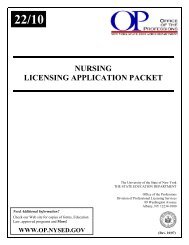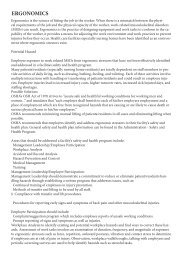TB Infection Control - Healthsource Global!
TB Infection Control - Healthsource Global!
TB Infection Control - Healthsource Global!
Create successful ePaper yourself
Turn your PDF publications into a flip-book with our unique Google optimized e-Paper software.
To be effective and reliable, respiratory protection<br />
programs must include at least the following<br />
elements:<br />
• Assignment of responsibility to one person<br />
with sufficient knowledge who is given the<br />
authority and responsibility to manage all<br />
aspects of the program.<br />
• Standard operating procedures that include<br />
information and guidance for the proper<br />
selection, use, and care of respirators.<br />
• Screening by a physician or other licensed<br />
health-care professional of all HCWs who<br />
might need to use a respirator for pertinent<br />
medical conditions at the time they are<br />
hired, and then re-screening periodically.<br />
• Annual training of HCWs with specific<br />
focus on prevention, transmission, and<br />
symptoms.<br />
• Selection of filtering facepiece respirators<br />
approved by CDC/NIOSH.<br />
• Fit testing performed during the initial<br />
respiratory protection program training and<br />
periodically thereafter, in accordance with<br />
federal, state, and local regulations.<br />
• Inspection and maintenance of respirators<br />
according to manufacturer instructions.<br />
• Evaluation of the respirator program<br />
periodically to ensure its continued<br />
effectiveness.<br />
Information on the development and management<br />
of a respiratory protection program is available<br />
in technical training courses that cover the<br />
basics of respiratory protection. Such courses<br />
are offered by OSHA, the American Industrial<br />
Hygiene Association, the American Conference of<br />
Governmental Industrial Hygienists, universities,<br />
manufacturers, and private contractors.<br />
Note<br />
The Centers for Disease <strong>Control</strong> and Prevention<br />
(CDC) is not a regulatory agency; CDC<br />
recommendations on infection control provide<br />
evidence-based guidance. For regulations in<br />
your area, refer to state and local regulations and<br />
contact your local Occupational Safety and Health<br />
Administration (OSHA) office. A directory of<br />
OSHA offices may be found at www.osha-slc.gov/<br />
html/RAmap.html.<br />
References<br />
CDC. Guidelines for preventing the transmission of<br />
Mycobacterium tuberculosis in health-care settings,<br />
2005. MMWR 2005; 54(No. RR-17).<br />
www.cdc.gov/mmwr/pdf/rr/rr5417.pdf<br />
Occupational Safety and Health Administration.<br />
Occupational safety and health standards, subpart<br />
I—personal protective equipment. Respiratory<br />
protection. Title 29, Code of Federal Regulations<br />
2003. Section 1910.134.<br />
www.osha.gov/pls/oshaweb/owadisp.show_<br />
document?p_table=STANDARDS&p_id=12716<br />
Additional Resources<br />
Websites:<br />
CDC Division of Tuberculosis Elimination:<br />
www.cdc.gov/tb<br />
CDC National Institute for Occupational Safety and<br />
Health: www.cdc.gov/niosh/topics/tb<br />
Occupational Safety and Health Administration:<br />
www.osha-slc.gov/SLTC/tuberculosis/index.html<br />
State <strong>TB</strong> control offices:<br />
www.cdc.gov/tb/links/tboffices.htm<br />
American Industrial Hygiene Association:<br />
www.aiha.org<br />
April 2010 www.cdc.gov/tb Page 2 of 2<br />
Safer . Healthier . People<br />
American Conference of Governmental Industrial<br />
Hygienists: www.acgih.org<br />
Fact Sheet:<br />
<strong>Infection</strong> <strong>Control</strong> in Health-Care Settings:<br />
www.cdc.gov/tb/publications/factsheets/prevention/<br />
ichcs.htm








